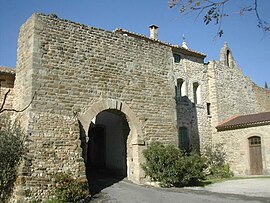Cairanne
| Cairanne | ||
|---|---|---|
| Commune | ||

Autanne Gate
|
||
|
||
| Coordinates: 44°14′02″N 4°56′03″E / 44.2338°N 4.9342°ECoordinates: 44°14′02″N 4°56′03″E / 44.2338°N 4.9342°E | ||
| Country | France | |
| Region | Provence-Alpes-Côte d'Azur | |
| Department | Vaucluse | |
| Arrondissement | Carpentras | |
| Canton | Vaison-la-Romaine | |
| Intercommunality | Pays Voconces | |
| Government | ||
| • Mayor (2001–2008) | Vincent Seve | |
| Area1 | 22.51 km2 (8.69 sq mi) | |
| Population (2006)2 | 893 | |
| • Density | 40/km2 (100/sq mi) | |
| Time zone | CET (UTC+1) | |
| • Summer (DST) | CEST (UTC+2) | |
| INSEE/Postal code | 84028 /84290 | |
| Elevation | 98–339 m (322–1,112 ft) (avg. 184 m or 604 ft) |
|
|
1 French Land Register data, which excludes lakes, ponds, glaciers > 1 km² (0.386 sq mi or 247 acres) and river estuaries. 2Population without double counting: residents of multiple communes (e.g., students and military personnel) only counted once. |
||
1 French Land Register data, which excludes lakes, ponds, glaciers > 1 km² (0.386 sq mi or 247 acres) and river estuaries.
Cairanne (Occitan: Cairana) is a commune in the Vaucluse department in the Provence-Alpes-Côte d'Azur region in southeastern France whose inhabitants were locally nicknamed leis afrontaires de Cairana, the cheeky ones from Cairanne.
It dates from the mid-8th century and is located midway between Orange and Vaison-la-Romaine. The village economy depends largely on its production of wine that falls into the various categories of wines from the Rhône valley.
The settlement was first mentioned in 739 CE as Queroana and later became known as Cayrane and then Cairanne. Early on the Church played a pivotal role in the political and cultural formation of the region. Christianity arrived in Provence very early and the region was already extensively Christianized by the third century CE with numerous monasteries and churches being constructed. The small fortified settlement of Cairanne became first a fortified village of the Templars, who in 1123 began with the construction of the ramparts. As was usual during these times the ramparts served both as a fortified wall and as housing for the local population.
In 1312, the order was officially disbanded by Pope Clement V, and some of its properties were assigned to the Knights Hospitallers, with much of it remaining in the hands of King Philip the Fair of France and King Edward II of England. Cairanne was henceforth ruled by the Knights Hospitallers, who later became known as the Knights of Malta.
...
Wikipedia



